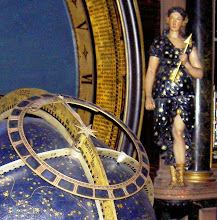
Sometimes in the middle of an otherwise busy landscape there are places which remain forgotten for years. They end up unknown, not just by Lunchista (who can usually claim the excuse of being new to a location) but by everybody. They may be bordered by overgrown hedges, or nondescript walls, which everyone simply ignores, or by advert hoardings, which everybody looks at without thinking what lies behind. They are often the site of some terrible industrial mistake, which seemed like a good idea at the time ("We could use that site for the new Asbestos works. It'll be Good For Jobs..." "Hey, you know that big hole where all the clay got dug out for bricks? Why don't we use that to dump all the town's rubbish in?") but left everybody with a mess that was harder to clean up than to hide.
The people who took those decisions will then have doubtless gone home, asked their children to tidy their rooms, and then told them off for hiding everything under the bed.
Years before Lunchista's arrival here, our city got a Natural Environment Trust, whose chair made it his business to find all the holes in the landscape with a view to identifying, and then looking after, all the wildlife within. In the days before Google Earth this was a lot of hard work: walking around everywhere and climbing over the odd wall. His prize find was a huge hole in the east end, surrounded by people's back gardens, where no-one ever went. He once described the sensation of finding it for the first time, as being like climbing through into an unknown other world. By an odd coincidence his name, but for one letter's difference, is Harry Potter.
It turned out to be a former landfill that had been capped off with clay in the 1970s. Nature had already made a good start on it: lots of brambles, bushes, and even some apple trees where the sweet factory had dumped all their unwanted bits of fruit. By the time Lunchista happened upon it, by spotting their wind turbine from the main road, several wildlife landscapes (woodland, meadow, pond...) had been created, as well as a central building run entirely on renewable energy, with its garden and log-store, and a thriving recycling business. And all before any of this became fashionable.
In the several years since then, woods have been planted, a shop has appeared, nature-related courses have started up, the Council's been so impressed it has started giving them money every year, and Lunchista has learned from them which plants will provide a free lunch and which would result in a swift trip to A&E.
I say "them" but it's now "us". Many of this type of place, even those which have no visible signs of work having been done to them, have a "friends of..." which anybody who knows the name of the place can join for a song. If you're new in a city, just put the city name and "friends of" into Google. Or better still, go walkabout (the best time for this is just after lunch, in January. Strange but true).
Every now and then the call goes out, come and help us plant trees (or build bird-boxes, or find out about spiders, or weave fences, or...). And then sit on the varandah (or in front of the stove, depending on the time of year), drink tea and home-made soup and have a chat.
Now who can refuse an offer like that?


No comments:
Post a Comment